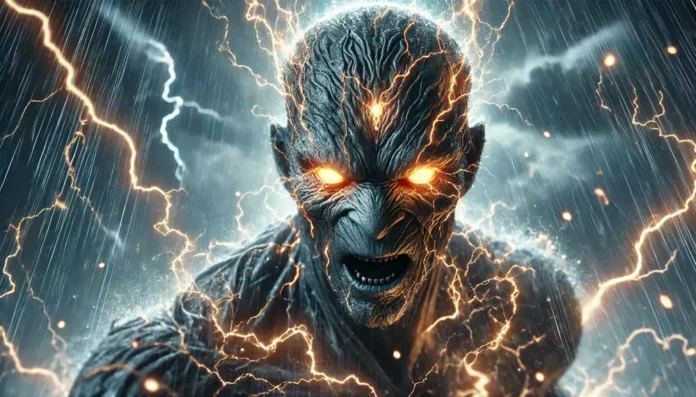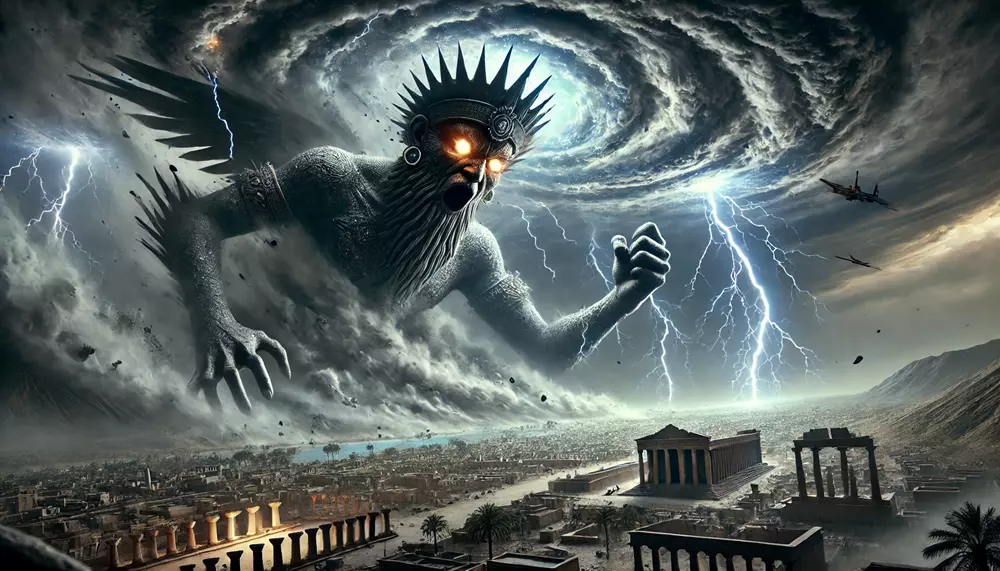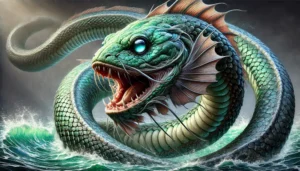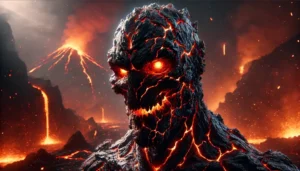Umu Dabrutu: Storm Demons of Mesopotamia
The Umu Dabrutu, known as storm demons in Mesopotamian mythology, are fierce and destructive beings associated with chaos and storms. These creatures were believed to have the power to control the elements, particularly the wind and rain, and could summon violent storms that brought devastation. With their humanoid forms surrounded by swirling winds and lightning, the Umu Dabrutu were feared as agents of destruction and chaos, wreaking havoc on cities and crops. Their association with the gods of weather and storms made them central figures in the ancient religious practices and mythology of the Akkadian and Sumerian cultures.
History/Origin
The origins of the Umu Dabrutu can be traced back to the ancient Akkadian texts, particularly during the rise of the Akkadian Empire (circa 2334–2154 BCE). These creatures were initially regarded as servants or extensions of the storm god Adad (or Ishkur), who wielded control over thunder, lightning, and rain. Their primary function in mythological tales was to unleash storms at the command of the gods or as manifestations of divine anger. The Enuma Elish, a famous Babylonian creation myth, also makes indirect references to demonic storm entities like the Umu Dabrutu, highlighting their integral role in maintaining cosmic order or unleashing chaos.
One of the earliest recorded references to these storm demons is found in the writings of the Neo-Assyrian Empire (circa 911–609 BCE). In one text, the Annals of Sennacherib, the Umu Dabrutu are mentioned as tools of divine wrath, sent by the gods to punish human cities that defied divine will. As the text explains: “The winds of Umu Dabrutu descended upon the rebellious city, scattering its walls and flooding its streets with the fury of Adad’s storm.” This highlights the perception of Umu Dabrutu as instruments of both cosmic retribution and environmental forces.
Throughout Mesopotamian history, depictions of Umu Dabrutu evolved. In early Sumerian art, these beings were depicted as vague, wind-like entities, often seen swirling in the background of carvings depicting gods like Enlil and Adad. However, as the Akkadian and Babylonian civilizations advanced, their depiction became more humanoid, emphasizing their destructive powers and fierce appearances. The violent winds that they were believed to command were feared by farmers, particularly during the planting and harvest seasons.
Name Meaning
The name “Umu Dabrutu” comes from the Akkadian words umū meaning “storm” and dabrūtu meaning “demon” or “evil spirit.” The direct translation, “storm demons,” aptly reflects their nature as creatures associated with violent weather phenomena. In Sumerian texts, they are sometimes referred to as “demon winds” due to their fierce, unrelenting power to summon destructive storms that could tear through cities and fields alike. Over time, the term “Umu Dabrutu” became synonymous with uncontrolled forces of nature and divine wrath.
Background Story
The most famous myth involving the Umu Dabrutu is tied to the Akkadian storm god Adad. According to ancient myth, Adad would summon the Umu Dabrutu whenever a city or king had angered the gods. In one tale, the city of Eridu defies the gods by refusing to offer sacrifices, and in retaliation, Adad releases the Umu Dabrutu upon the city. The storm demons, with their wind-whipped forms, descend upon Eridu, summoning a tempest that floods the streets and levels buildings. The people of Eridu attempt to appease Adad, but the storm continues until the city is reduced to ruins.
Another story involves the Battle of the Winds, where the Umu Dabrutu are pitted against the divine hero Ninurta, a warrior god of agriculture and storms. In this tale, the demons are sent by Enlil, the king of the gods, to prevent Ninurta from retrieving the Tablet of Destinies. The ensuing battle sees Ninurta battling against the chaotic winds and lightning summoned by the Umu Dabrutu, ultimately prevailing through his divine strength and cunning. This myth showcases the Umu Dabrutu as embodiments of nature’s destructive forces, but also highlights how these forces can be controlled by divine will.
Cultural Impact
The influence of the Umu Dabrutu on Mesopotamian culture was profound, particularly in their association with storms and natural disasters. Farmers and priests would regularly invoke the storm gods to protect their crops from the destructive winds and rains that the Umu Dabrutu were believed to bring. In some cases, offerings were made directly to the storm demons themselves in an effort to appease them and prevent disaster.
In the Ziggurats of Babylon, there are reliefs that depict scenes of violent storms, with swirling winds often personified as demonic entities resembling the Umu Dabrutu. These images were believed to symbolize the uncontrollable nature of storms and the need for divine intervention to protect the city from their wrath. The Ziggurat of Ur, in particular, contains inscriptions invoking the protection of Enlil and Adad from these demonic storm winds.
In religious rituals, the Umu Dabrutu were often mentioned in prayers during the planting and harvest seasons. Farmers would pray to the gods to keep the destructive demons at bay, asking for gentle rains rather than the tempestuous storms that the Umu Dabrutu represented. These rituals were particularly common during the annual Akitu Festival, a New Year’s celebration where the gods were asked to ensure the fertility of the land and protect it from natural disasters.
The Umu Dabrutu were also invoked during times of war. Mesopotamian kings, particularly in the Neo-Assyrian Empire, would offer sacrifices to Adad before military campaigns, asking for the Umu Dabrutu to unleash storms upon their enemies. One Assyrian inscription reads: “Let the winds of Umu Dabrutu scatter our foes, as they scatter the fields in their fury.” This highlights how these storm demons were not only seen as natural forces but also as potential allies in times of conflict.
Scientific or Rational Explanations
Modern scholars have often attempted to rationalize the existence of the Umu Dabrutu by connecting them to natural phenomena. Some historians believe that these storm demons were a personification of the frequent and violent storms that swept through Mesopotamia, particularly in the spring and summer months. The destructive winds, flash floods, and lightning storms that regularly plagued the region would have seemed like the work of malevolent forces to ancient peoples who lacked a scientific understanding of weather patterns.
Additionally, scholars suggest that the tales of the Umu Dabrutu may have been influenced by large-scale natural disasters, such as floods or severe windstorms, that periodically struck ancient Mesopotamian cities. These disasters would have reinforced the belief in storm demons as beings sent by the gods to punish or test humanity.
In Modern Culture
The legacy of the Umu Dabrutu continues to echo in modern literature, video games, and other forms of popular culture. While not as widely known as other mythological creatures, their presence as agents of chaos and destruction has been adopted into various works of fiction.
Dungeons & Dragons
In various campaigns and expansions, storm demons that bear a striking resemblance to the Umu Dabrutu appear as formidable adversaries. These demons often command powerful weather magic, unleashing hurricanes and storms upon adventurers.
Assassin’s Creed: Origins
In this video game, there are references to Mesopotamian mythology, including storm-related deities and demonic forces. While the Umu Dabrutu are not mentioned by name, players encounter several powerful storm entities that embody their chaotic nature.
Final Fantasy Series
In the Final Fantasy universe, storm demons inspired by the myth of the Umu Dabrutu can be found as bosses or enemies. These creatures typically have powers over lightning and wind, reflecting the original mythological role of the storm demons.
Neil Gaiman’s American Gods
Gaiman’s work frequently touches on forgotten gods and mythological beings, including references to storm deities and demons. Though not explicitly named, the chaotic and destructive nature of storms in his world has roots in ancient beliefs like the Umu Dabrutu.
The Elder Scrolls V: Skyrim
In this popular RPG, several demonic entities appear that control the weather, particularly storms. These entities draw inspiration from ancient mythological figures like the Umu Dabrutu, showcasing how these creatures continue to influence modern fantasy storytelling.
The Umu Dabrutu serve as a reminder of humanity’s historical struggle to understand and control the destructive forces of nature. Though their names may be lesser-known, their influence persists, especially in portrayals of storm-related deities and demons in modern media.
Conclusion
The Umu Dabrutu, with their fearsome power over storms and winds, have played a crucial role in Mesopotamian mythology. As both agents of divine wrath and embodiments of chaotic forces, they have left an indelible mark on religious practices, art, and literature. Their presence in modern culture, though subtle, reflects humanity’s enduring fascination with the untamable forces of nature. Whether as feared entities or symbols of divine punishment, the Umu Dabrutu remain powerful figures of chaos and destruction.










